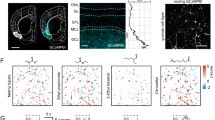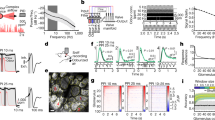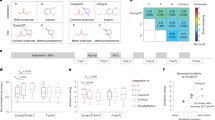Abstract
MANY sensory systems have evolved signal detection capabilities that are limited only by the physical attributes of the stimulus1. For example, 'hair' cells of the inner ear can detect displacements of atomic dimensions2. Likewise, both in vertebrates and in invertebrates photoreceptors can detect a single photon3,4. The olfactory stimulus also has a quantal unit, the single odorant molecule. Insects are reportedly able to detect a single pheromone molecule5, whereas quantal responses in vertebrate olfactory receptor cells have not been reported yet. Psychophysical measurements indicate that a minimum of 50 odorant molecules are necessary for human olfactory detection, suggesting that an individual receptor may be activated by a single odorant molecule6. We report here measurements of current fluctuations induced by odorants that suggest a quantal event of about 0.3–1 pA, presumably triggered by the binding of a single odorant molecule.
This is a preview of subscription content, access via your institution
Access options
Subscribe to this journal
Receive 51 print issues and online access
$199.00 per year
only $3.90 per issue
Buy this article
- Purchase on Springer Link
- Instant access to full article PDF
Prices may be subject to local taxes which are calculated during checkout
Similar content being viewed by others
References
Block, S. M. in Sensory Transduction (eds Coirey, D. P. & Roper, S. D.) 1–17 (Rockefeller Univ. Press, New York, 1992).
Crawford, A. C. & Fettiplace, R. J. Physiol. 364, 359–379 (1985).
Baylor, D. A., Lamb, T. D. & Yau, K. W. J. Physiol. 288, 613–634 (1979).
Fuortes, M. G. F. & Yeandle, S. J. gen. Physiol. 47, 443–463 (1964).
Kaissling, K. E. A. Rev. Neurosci. 9, 121–145 (1986).
de Vries, H. L. & Stuiver, M. in Sensory Communication (ed. Rosenblith, W. A.) 159–167 (Wiley, New York, 1961).
Firestein, S., Picco, C. & Menini, A. J. Physiol. 468, 1–10 (1993).
Kleene, S. J. & Gesteland, R. C. J. Neurosci. 11, 3624–3629 (1991).
Kurahashi, T. & Yau, K. W. Nature 363, 71–74 (1993).
Nakamura, T. & Gold, G. H. Nature 325, 442–444 (1987).
Zufall, F., Firestein, S. & Shepherd, G. M. J. Neurosci. 11, 3573–3580 (1991).
Lamb, T. D. & Pugh, E. N. Trends Neurosci. 15, 291–298 (1992).
Nunn, B. J. & Baylor, D. A. Nature 299, 726–728 (1982).
Baylor, D. A., Nunn, B. J. & Schnapf, J. L. J. Physiol. 357, 575–607 (1984).
Schnapf, J. L., Nunn, B. J., Meister, M. & Baylor, D. A., J. Physiol. 427, 681–713 (1990).
Trotier, D. Pflugers Arch. 407, 589–595 (1986).
Firestein, S. & Werblin, F. Proc. natn. Acad. Sci. U.S.A. 84, 6292–6296 (1987).
Kurahashi, T. J. Physiol. 419, 177–192 (1989).
Lynch, J. W. & Barry, P. H. Biophys. J. 55, 755–768 (1989).
Author information
Authors and Affiliations
Rights and permissions
About this article
Cite this article
Menini, A., Picco, C. & Firestein, S. Quantal-like current fluctuations induced by odorants in olfactory receptor cells. Nature 373, 435–437 (1995). https://doi.org/10.1038/373435a0
Received:
Accepted:
Issue Date:
DOI: https://doi.org/10.1038/373435a0
This article is cited by
-
Policy, toxicology and physicochemical considerations on the inhalation of high concentrations of food flavour
npj Science of Food (2020)
-
Loss of variation of state detected in soybean metabolic and human myelomonocytic leukaemia cell transcriptional networks under external stimuli
Scientific Reports (2016)
-
Stable Odor Recognition by a neuro-adaptive Electronic Nose
Scientific Reports (2015)
-
Neural Computations with Mammalian Infochemicals
Journal of Chemical Ecology (2008)
-
The sense of smell, its signalling pathways, and the dichotomy of cilia and microvilli in olfactory sensory cells
BMC Neuroscience (2007)
Comments
By submitting a comment you agree to abide by our Terms and Community Guidelines. If you find something abusive or that does not comply with our terms or guidelines please flag it as inappropriate.



